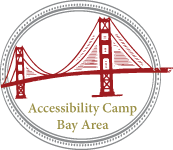2019 Talks
This page has information on the 15 talks at this year's camp which will give you a feel of what to expect during the day. The schedule is now live.
Track A
The Importance of Semantics (For Designers and Developers)
Abstract
Semantics on the web have to do with the implied meaning and interaction of a particular element, and they are the backbone of web accessibility.
Choosing the right element, and using it in the correct way, is crucial to providing an accessible and usable experience and is important to both designers as well as developers.
Hosted by: Gerard Cohen
Let's Talk Hardware Accessibility
Abstract
Information Technology Hardware ecosystem touches nearly everything we do. The variety of hardware products from mobile, telephony, laptops, wearables, and the internet of things are just some of the trends in technology that have become routine in our everyday life. Attend this talk to learn about why hardware accessibility is essential for everyone, and how HP designs and evaluates for hardware accessibility.
Hosted by: Sam Ogami
WCAG 2.1 Update for Designers
Abstract
WCAG 2.1 was released in mid-2018 adding 17 new success criteria to WCAG 2.0. Designers (UX, visual and content) have responsibility for most of these in addition to requiring developers to implement them well. Andrew will discuss the design implications with some hands-on exercises to highlight the requirements.
Hosted by: Andrew Arch
If accessibility is the why, inclusive design is the how
Abstract
I left Adobe Accessibility at the end of 2017 to start an inclusive design team inside Adobe Design. But wait--isn't inclusive design just a cool new way to say accessibility? Nope! Inclusive design turns the focus where it belongs: on the entire process, from its conception, not just on the implementation phase and its final code and content artifacts. It's also an opportunity to link disability communities with other stakeholder groups in diversity, equity and inclusion (DEI). This session will cover why inclusive design exists in concert with, but distinct from accessibility-oriented communities of practice.
Hosted by: Matt May
Using Cognitive Walkthroughs for a Task-Oriented Accessibility Review
Abstract
Learn to use the UX technique of cognitive walkthroughs to walk through tasks using personas that represent users with different access requirements. This is a great way to review designs or existing sites or apps that focuses on the tasks a user wants to complete rather than the product as a whole.
Hosted by: Sarah Pulis
Track B
Braille on the Web
Abstract
Learn how people read and write Braille on the web, and how you can apply web standards to ensure your content is accessible. We'll discuss the operation of a refreshable Braille display, how these devices interoperate with web browsers, and some interesting challenges we faced building an accessible math editor.
Hosted by: Jason Merrill and Steve Clower
Building accessible applications with Ember.js
Abstract
The ability to more easily build accessible single-page applications has become much easier in Ember.js, due to concentrated efforts by the Core Team and accessibility advocates. This talk will show you just how that's possible.
Hosted by: Melanie Sumner
Building an Accessible e-Book Reader for the Web
Abstract
Building an e-Book reader is hard, making it accessible is an even greater challenge. In this session, you'll learn the story of how we built one. We will share the lessons we have learned, the design patterns and code snippets we used, and the results of our user studies.
Hosted by: Ugi Kutluoglu
State of Digital Accessibility in U.S. Higher Ed
Abstract
We will discuss the requirements and environment surrounding accessibility in Higher Ed institutions in the U.S., and attempts to tackle these challenges. We will go on a panorama tour of the structure and culture of large universities and their constituents; touch on how accessibility fits into teaching, research and administration responsibilities; cover perspectives from legal, students, faculty, support staff; and take a look at policies, operations and culture impacting accessibility efforts.
Hosted by: Jiatyan Chen
Dark Patterns from the Lens of Accessibility
Abstract
Dark Patterns harm all users. However when a company decides to make their Digital Products accessible, tolerance of Dark Patterns can completely undermine their credibility and real world accessibility.
Hosted by: Joe Devon
Track C
So you want to be in Accessibility? . . .
Abstract
People decide they want to get involved with accessibility for many different reasons, with varying degrees of financial and employer support. This session will discuss different types of learning available at various price points (including free) to build a ladder to the ultimate accessibility career.
Hosted by: Sheri Byrne-Haber
Sharing the Accessible Journey for Impact
Abstract
Are you an advocate struggling to effectively communicate your accessibility story? This conversation will focus on how to engage stakeholders in meaningful conversations to advance accessibility. Bring your stories of success and challenges.
Hosted by: Tim Hohne
Designing Accessible Color Systems
Abstract
Choosing accessible colors for UI doesn’t have to involve guesswork. Come learn about the math and color science behind building a color system based on accessible contrast ratios. I'll share our approach to defining Handshake's accessible color palette and share some homegrown tools you can use in your own work!
Hosted by: Brad Turner
Inclusive Content Strategy
Abstract
Inclusivity is at the heart of effective content strategy. Accessible code may be imperative for inclusion, but code doesn’t do any good if the content is not meaningful to readers. We’ll go over what we can do as content authors to ensure our readers feel that we are speaking with them, not at them.
Hosted by: AmyJune Hineline
Screen Readers for Sighted People: what the web is like, and why it matters
Abstract
The web's lack of UI standardization makes it very inconvenient for people who use screen readers. What's it like? What coping tactics do they use and how are they limited? How can web developers help? And why does it matter for the everyone?
Hosted by:Adrian Bauer
